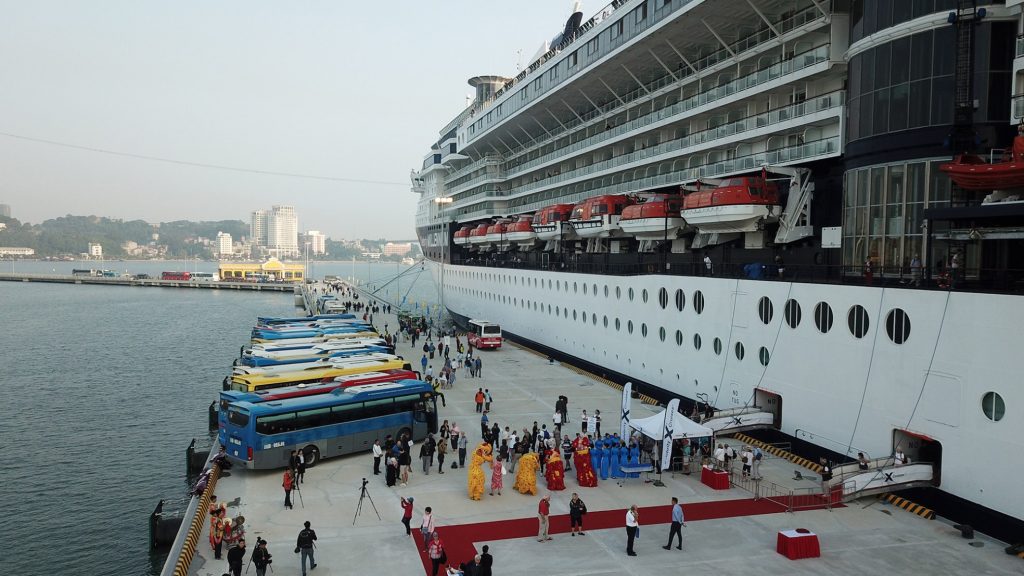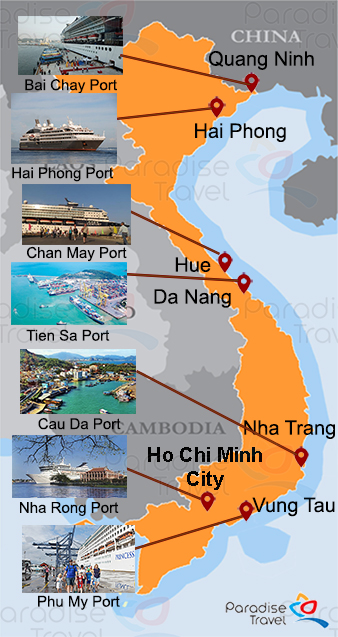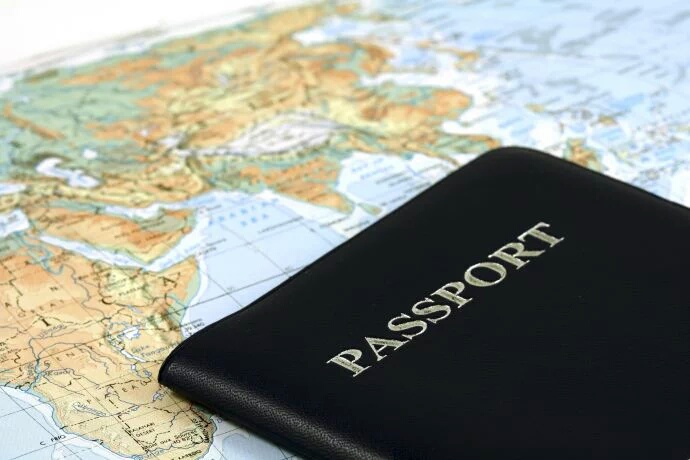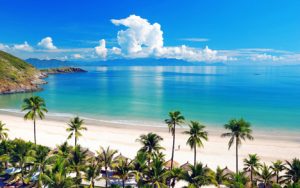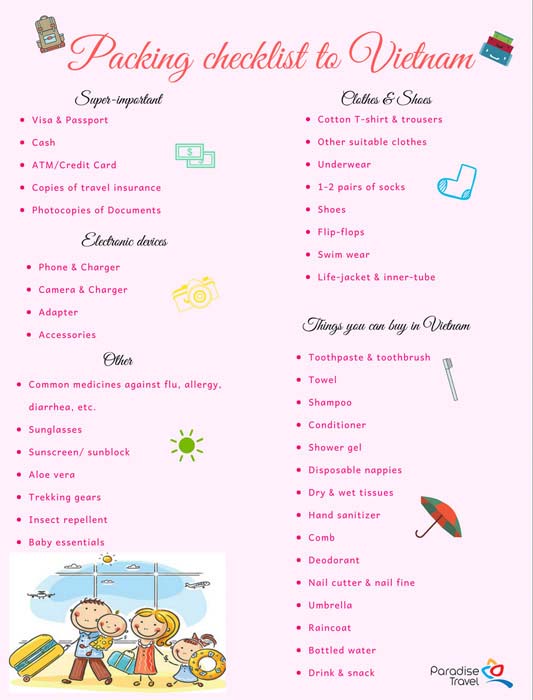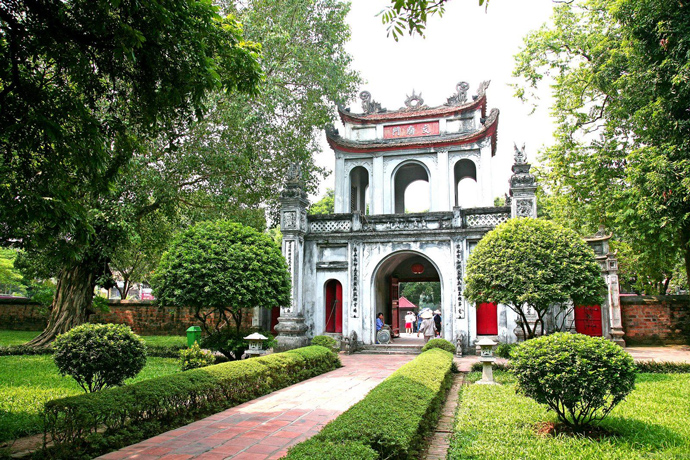Best Time to Visit Vietnam
The weather in Vietnam can be split into three regions. The country has a tropical climate with four seasons in the north and two seasons (dry and wet season) in the center and the south. In the north, it is sultry from May to August and cold from December to the beginning of February. In summers, Northern Vietnam is mainly affected by typhoons, which interrupted your outdoor excursion. The Central and Southern Vietnam usually rains from June to October and stay dry and hot from March to May. In general, the best time to travel to Vietnam is from November to April.
Northern Vietnam Shore Excursions

- Halong Bay
Northern Vietnam’s weather is characterized by its distinct four seasons. The humidity level is usually high in this region, especially during spring (February – April) and summer (May – August).
It is cold in the north during winter (December – early February), and the temperature may drop to 0 degree Celsius in the mountainous area. After Vietnamese Lunar New Year, spring comes, the weather starts getting warmer and it is the best time for Halong Bay shore excursions. The sky is blue and clear, which is perfect for cruising and kayaking.
This region is affected by heavy rains, storms and typhoons from July to September, so be careful if you want to travel to mountainous areas at this time. Autumn (late September – November) is the best time to visit Hanoi since tourists will be rewarded with pleasant weather with light breeze, flower blooming, and rustic sceneries.
Central Vietnam Shore Excursions

- Hoi An
Generally speaking, Central Vietnam is warm all year-round with the temperature ranging from 25 to 35 degrees Celsius.
It is usually hot in Da Nang and Hoi An during summers, and it is also a high domestic tourism season. Thus, it is recommended that you visit these places between February to July, before the region is affected by the monsoon and heavy rain from September to early January.
On the contrary, the weather is more stable in South Central Coast (Nha Trang, Quy Nhon) with warmth and sunshine all year-round. However, it drizzles from September to November and there might be heavy rains.
Southern Vietnam Shore Excursions

- Ho Chi Minh City
The South of Vietnam has only two distinct seasons: dry season and rainy season with the average temperature of 25-35 degrees Celsius year-round. It is mostly hot all the time and there is no chilly winter like the Northern area.
Basically, the Southern people experience dry season between December and April in which it is sultrier and more humid from February (after Tet holiday) to April.
The rainy season ranges from May to early November when this area will receive the highest rainfall in June, July, and August. However, you do not have to worry too much about the rains, since it usually rains in the afternoon and will not interrupt your sightseeing time.
Phone, Wifi, Internet Services and Power Socket in Vietnam

- 3 most famous mobile service providers in Vietnam
- Wifi connection is relatively good in hotels, coffee shops and restaurants in Vietnam. Take advantage of free wifi to contact your family and friends through Skype, Viber or Whatsapp.
- However, if you travel to rural areas where wifi connection is interrupted, we highly recommend you purchase a SIM Card in Hanoi or Ho Chi Minh City for internet service. It is easy to find a Viettel and Vinaphone official store in the city center or at the airport. Check with us then we will prepare a free SM Card for you.
- We use 220V, 50Hz and 2 and 3-pin electricity socket in Vietnam. Most hotels will provide electric outlets which accept many plug shapes. Universal travel adaptors are needed if you travel with many devices.
Currency Exchange and ATMs
Vietnam’s official currency is Vietnam Dong (VND). Vietnam Dong comes in polymerized notes (there are no coins used in Vietnam). The smallest bill in Vietnam is VND 500 and the highest value note in Vietnam is VND 500,000.
There are many local and international banks in Vietnam (ANZ, HSBC, Shinhan, Public Bank). Do not worry about any issue with money exchange before your Vietnam shore excursion tour, it is very easy to exchange currency at banks in Vietnam.
Packing Tips to Vietnam
Don’t go crazy about packing. There are many supermarkets and convenient stores (Circle K, Shop & Go, Family Mart, etc.) around Vietnam, especially in tourist destinations such as Hanoi, Da Nang, Nha Trang, and Ho Chi Minh City.
These are essential things you can prepare before Vietnam shore excursion:

- Passport, cash and visa card
- Clothing: Vietnam is hot and humid year-round, so make sure you pack light clothing. Cotton T-shirts and pants should be included in your luggage. Stay away from heavy fabrics because they will make you sweat. However, if you travel to the Northern area during winters, coats, sweaters, and hoodies are needed.
- Prescript medicines
- Mosquito repellent
- Sun-protection items: sunscreen and sunglasses. You can buy hats in Vietnam.
Transportation in Vietnam
Public transportation is currently not well-developed and well-integrated in Vietnam, therefore taxi and walking are the main way to go around big cities like Hanoi and Ho Chi Minh City. Grab can be used in main travel destinations in our country.
If you travel to different towns within one region, bus and train are the main means of transport. Bus tickets range from VND 100,000 to 500,000 dong, depending on the distance. You can look for cheap deal on low-cost airlines such as Vietjet Air and Jetstar.
Safety Tips in Vietnam

- Always bring water with you
There are several Vietnam travel risks related to the weather in Vietnam. As an elongated country, the temperature changes significantly from the north to the south. Do not participate in any outdoor activity at sweltering noon. Carry a bottle of water with you to avoid dehydration.
Do not flash your belongings, jewelry, and electronic devices. Refrain yourselves from taking a photo or using your smartphone while walking on the streets.
As the second largest motorbike ownership in the world, traffic here should be on your list of Vietnam travel risks. Traffic is inexcusably horrible on working hours, on peak hours of the weekends and on public holidays as well. Don’t be panic when crossing the street, the locals are always willing to help you.
Cultural Manners and Etiquettes in Vietnam You Should Know

- Temple of Literature – Hanoi
Don’t wear shorts, skirts and sleeveless tops when entering a religious site. Wear long pants or dresses, cover your shoulders, remove your hats and leave your shoes at the door.
Vietnamese people dress conservatively and do not reveal too much skin, so make sure you respect our customs.
Tipping is not mandatory in Vietnam. However, a small tip is fine if you are satisfied with the service. Here are our suggested tipping amounts in Vietnam:
- Hotel and Restaurant: Service charges are already included in the bills.
- Porter: $1-$2 tip will be appreciated.
- Guide: $5-$10 per day per person.
- Driver: $2-$5 per day per person.
When meeting a new Vietnamese friend, it is not common for giving a kiss or a hug. A smile is fine and you may shake hands.
It is not common for couple’s public displays of affection in Vietnam, so refrain yourself.
Nude sunbathing is banned in our country, even on the beaches.



